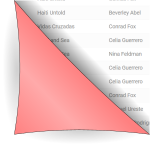
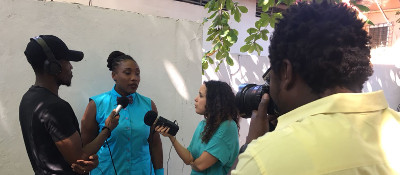

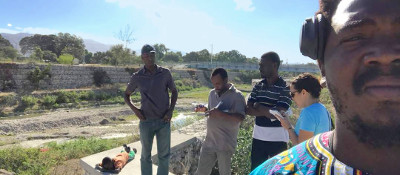
Haiti has a proud history. In 1803, the world's first successful slave revolt threw off its colonial masters and established the first Black republic. So how did a proud and powerful country become the poorest in the Western hemisphere and one of the most unequal in the world? In Haiti Untold, we answer that question through the voices of people in the urban ghettoes, the upmarket enclaves, and the forgotten countryside. Our teams of reporters from Haiti and the US, working in equal partnership, share skills and information to bring their stories to light.
Ayiti gen yon istwa ekstraòdinè. An 1803, li reyalize premye revolisyon esklav nan mond lan ki rive chavire system kolonyalis la epi kreye premye repiblik Nwa endepandan. Koman Ayiti pral soti nan peyi ki fyè, ki fò pou l vin tounen youn nan peyi ki pi pòv nan emisfè oksidantal la epi ki gen epi gen inegalite sosyal nan mond lan? Nan Ayiti Dekouvri, nou reponn kesyon sa a atravè vwa moun nan katye popilè yo, vil yo, bèl katye, ak moun kap viv andeyò. Ekip nan repòtè nou yo soti an Ayiti ak US la, k ap travay nan patenarya egal, ladrès pataje ak enfòmasyon yo pote istwa yo nan limyè.
Haiti Untold brings to light stories about structural inequality in Haiti, stories that are especially relevant to a Haitian audience but also to an audience in the United States. See all our stories here.
Dekouvri Ayiti mete pwojektè sou istwa inegalite estriktirèl ki gen an Ayiti, istwa sa yo gen espesyalman rapò ak piblik ayisyen an, men tou moun kap viv nan peyi Etazini. Ou ka gade tout istwa nou yo isit la.
Prisoners to puppeteersAida Alami and Michel JosephEighty percent of people in prison in Haiti are awaiting trial - sometimes for years, even if they are innocent. Conditions are so bad, prisoners have died of hunger. Now artists, including ex-inmates, are using art to get the public's attention on the plight of thousands of men languishing in Haiti’s jails.
|
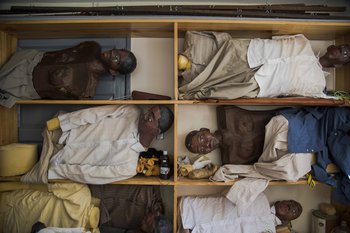
|
Prizonye pou marionnettesAida Alami ak Michel JosephKatreven pousan moun ki nan prizon an Ayiti ap tann jijman - pafwa pou ane sa yo, menm si yo inosan. Kondisyon yo pa bon yo, prizonye ki te mouri grangou. Koulye a, atis ki enkli ansyen détenus, ap itilize atis pou rive atansyon piblik la sou li a retransmèt de milye de moun languishing yo ki nan prizon an Ayiti.
|
Rejuvenating riceAida Alami and Phares JeromeHaiti used to grow enough rice to feed itself until it was forced to drop its tariff barriers. Now it imports 80% of its rice, most of it from the US. A new government investment program has some farmers hopeful things could. One small company even plans to export back to the US.
|
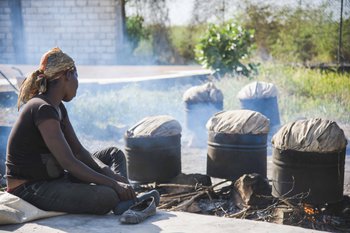
|
Prix diriAida Alami ak Phares JeromeAyiti te itilize pou devlope ase diri pou bay manje tèt li jiskaske li te fòse pou li baryè tarif. Kounye a li enpòte 80% diri li, sa soti nan peyi Etazini. Yon nouvo gouvènman an envèstisman pwogram gen kèk fèmye èspwa sa te kapab. Yon sèl ti konpayi an menm te gen plan pou ekspòtasyon tounen pou Etazini.
|
Carnival of ChangeAida Alami and Michel JosephEach February, the city of Jacmel holds a giant 24-hour party, with parades of elaborate artwork and flamboyant costumes. This year, the theme of Carnival was “Change” - sending a powerful message to the government and to the world.
|
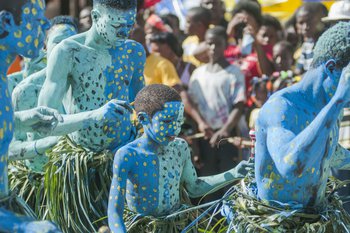
|
Kanaval de chanjmanAida Alami ak Michel JosephChak mwa Fevriye, vil Jakmèl a chaje yon gwo 24 trè sou pati, avèk parad élaborer une ak grandyoz pandan. Ane sa a, tèm kanaval li te genyen "Chanjman" - voye yon mesaj ki pwisan pou gouvènman an e pou mond lan.
|
Our unique partnership model pairs young reporters from Haiti with their counterparts from the United States. Read about our team and the work they have done here.
Modèl patenarya inik nou an asosye jèn repòtè ki soti Ayiti ak tokay yo nan peyi Etazini. Dekouvri ekip la ak travay yo fè isit la.
Michel and I were on equal footing, paid the same amount by Round Earth and equally invested in producing content for our respective outlets. I love the idea of Michel’s work, in which I played a part, reaching every corner of Haitian society. I love the idea of Round Earth partnerships catching fire and spreading into continuously expanding networks between journalists across borders in the years to come.
Michel ak mwen te sou menm nivo nan projè Round Earth, nou te touche menm kantite lajan epi nou te gen men ròle nan prodiksyon repotaj yo. Mwen te renmen lide Michel yo, mwen te pataje anpil ladan yo . Mwen te santi empotans ròle mwen nan chak kwen sosyete a . Projè patenarya Round Earth la se tankou yon difè ki gaye ki ap pran fos ka jounalis ki gen pou travèse fontyè nan lané kap vini yo.
In a country like Haiti where most journalists don't do field work, Round Earth Media allowed me to dig deep. Close to a hundred interviews, entire days spent in the streets of Port-au-Prince, Jimani, Malpasse, Cap Haitien, Terrier Rouge, Ouanaminthe, Gonaives, and Lestere. [This project has] convinced me more than ever that the craft of a journalist is the same throughout the world.
Nan yon peyi tankou Ayiti kote pifò jounalis pa fè travay sou plas, Round Earth Media te pemèt mwen fouye dosye yo pi fon . Lò nou te fini fè prèsk 200 entwèvi ak lò nou fè tout jounin ap mache nan lari Pòtopwens, Jimani, Malpasse, Cap Haitien, Terrier Rouge, Ouanaminthe, Gonaïves ak Lestere. [Projè sa] vini konvenk mwen ke pwofesyon jounalis la se menm bagay toupatou sou latè.
The media outlets that publish and broadcast our stories reach broad audiences throughout Haiti and also in the United States. Read about them here.
Medya ki pibliye epi ki difize istwa nou yo rive atenn yon gwo kantite moun an Ayiti tankou Etazini. Li sou yo isit la.




